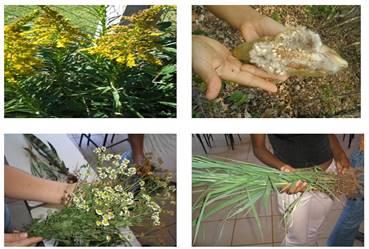Introduction
The dialogue in school education is a communication relationship through which the realities are unveiled and the subjects involved in the educational processes become critical, reflective and independent. In the dialogue between educators and students, differences must be exposed, heard and respected (Freire, 2005).
Under the logic of modern science, the school classified knowledge into two similar categories: scientific knowledge and popular (empirical) knowledge. Scientific knowledge would be that built in obedience to scientific principles, in turn submitted to the logic of the positivist paradigm: search for scientific truth; primacy of the method over the knowing subject and its criterion of validity; objectivity of the investigation process; impartiality of scientific knowledge; neutrality of the scientist.
Popular knowledge would be, in opposition to scientific knowledge, that “traditional” produced by the “people” in social relations, in non-academic spaces, not based on scientific principles. The 'traditional', in this way, associated with historical immobility, economic backwardness, stagnation.
For Leff (2003), the dialogue is established within a rationality that seeks to understand the other, without encompassing cultural differences in a universal background and without translating “the other” in terms of “the same”. That is, the dialogue, for seeking mutual respect, must allow the coexistence of different cultural knowledge, enriching each other.
This author asserts that from the conception of an environmental education founded on the interdisciplinary articulation of the natural and social sciences, a progress was made towards a vision of environmental complexity open to different interpretations of the environment and to a consistent dialogue of knowledge.
According to Shoutherland (2000), dialogue in the classroom promotes opportunities for students to realize the differences between the procedures, goals, uses, possibilities and limitations of the various knowledge systems. Specifically, the dialogue allows students to perceive the differences between their knowledge and the scientific knowledge worked at school.
It is believed that the dialogue between knowledge in Science Education constitutes a culturally appropriate teaching practice, as it contributes to the student realizing that science is not the only way to access knowledge, as well as promoting thought and reflection criticism about different knowledge and ways of knowing.
Botany as a science can be strategically applied as an integrating link of environmental issues. With environmental awareness as a central assumption, the study of plants within a systemic view allows for an interconnection between natural aspects, expanding the ranges of action for various themes necessary for this awareness to materialize. When developing a theme with plants, it is impossible to dissociate it from caring for the soil, ecosystems, the economic use of natural resources, the food chain, among others. This science is seen as a central theme that allows the necessary contextualization for the development of several environmental themes.
The teaching of botany, lately, does not serve the interests of a student class that comes up against continuous changes and technological advances, even causing aversion and total disinterest by most students. There are several authors who reveal that the traditional and systematic approach with which Botany has been treated is that which reflects, for this very reason, the low performance of students in this content.
Botany is one of the areas that have the greatest difficulty in assimilating content, which is often associated with teachers, who, due to not having sufficient and adequate training, end up treating matters very superficially or even ignoring them under the allegation of lack of affinity, not only for them but for the students (Nascimento, et al, 2017).
As a branch of biology, within the teaching of science, botany arouses little interest in students to the detriment of being quite elaborate, somewhat complicated, with nomenclatures (terminologies) that are difficult to assimilate. This difficulty, added to the teachers' low sensitivity to the issue, in addition to the lack of practical instruments capable of providing a theoretical complement in the area, can generate epistemological obstacles to learning. The need to improve methods in the teaching of Botany has sparked several initiatives in the construction of new pedagogical proposals, however, little has been done to effectively verify how these initiatives take place and what guarantees their effectiveness, in the expected conceptual significance.
Organizing the Teaching of Botany is not an easy task, since the list of contents is extensive and the time reserved for this area ofBiology is small. There is also the factor of great plant biodiversity and the ability of the teacher to organize his classes. Therefore, it is noted the importance of using the teaching methodology as a pedagogical tool that leads to thinking about new and varied forms of teaching. Preserving popular culture about the use of medicinal plants as a means of stimulating the learning of Botany, inserted in a Environmental Education project, it becomes a very interesting attempt. Ethnobotany values popular knowledge, starting from them to build an empirical reference and, then, to deepen their studies. In teaching, this branch of Biology can and should be understood as a valuable resource, that is, identifying the flora of the environment in which the students and their ancestors were inserted can make the teaching of Botany part of their lives, of the world itself.
As for the teaching approaches and strategies used, Ursi, et al. (2018), comments that in many circumstances the teaching of Botany is undertaken in a decontextualized way, this being probably one of the main factors causing the greatest disinterest and learning difficulty on the part of students in this area of biology. The lack of practical activities of different natures and the limited use of technologies, especially digital ones, so familiar and common to most students, also represent obstacles in this regard. Another particularly important point to be taken into account for botany is the presence of an evolutionary approach, capable of giving more coherence to the study of plant classification.
One of the measures to be taken to change this situation, is to make teachers aware that the teaching of Botany does not need to stick only to the information contained in textbooks and in the media, but rather needs more practical classes, especially in the field, so that the student perceives and rescues the man-nature relationship. For Araujo Torres de Melo Moul, & Lins Da Silva (2017), this problem of botany that is repeated in teaching environments, where students do not learn and their low grade concepts, reveal only their lack of interest in the content. On the other hand, these data generate concerns that bring us questions, to the point of leading us to a reflection on the pedagogical practice, in order to know if this problem is related only to the students' disinterest. The authors question whether the way in which content is approached and how teaching and learning are made operational would also not influence these results in the classroom.
Materials and methods
The work exposed here was carried out within the scope of a community of quilombo remnants, located in the Central region of the State of Mato Grosso do Sul, Brazil. The community is called Furnas do Dionísio and the work, with a qualitative and ethnographic approach, was part of a master's dissertation in Science Teaching, with a line of research in Environmental Education.
The community is in the rural environment, presenting a population formed predominantly of Afro-descendants, which emerged from the migration of its founder, from the state of Minas Gerais to this place, in 1890. According to reports, he was a cowboy and got to know the region thanks to trips accompanying cattle delegations. The fact is that he settled with his family and later bought the area that includes a valley of fertile land and lush vegetation. The community has approximately 89 families, equivalent to 335 people in all.
The choice of informants was based on the indication of the school's students. They elected some residents to the researcher who could respond to the ethnobotanical forms for presenting an expressive knowledge about plants in the community, which was called specialist residents.
The informants were approached directly at the interviewee's home, where the objectives of the work were explained in detail. In addition, an Informed Consent Form was delivered, where all the information with its respective objectives and steps were presented in this document. For their agreement, they counted on their availability, interest and goodwill and this implied a little time demand, but also very salutary, since from this moment, an atmosphere of good friendship was created, where conversations flowed reliably, and thus, the data collected was more reliable.
It is worth mentioning that the receptivity was cordial on the part of all residents approached in their homes and even for informal conversations by the community, demonstrating a secular education in a good neighborhood, which must have been acquired from their ancestors.
The collections of medicinal plants were made with the residents at the time of the interviews and / or in subsequent visits. The preferably fertile botanical material was herborized according to conventional methodology applied in plant taxonomy. Several plants mentioned were collected in the presence and with the help of the informants. The testimony botanical material was deposited and registered at the Herbarium of the Federal University of Mato Grosso do Sul.
After the part of carrying out the study in the community, the interventions and the beginning of classroom research activities, which are the subject of this article, with the students, only started with the authorization of the school's management.
The students had their syllabus completed until the middle of the 3rd Bimester (from the 1st, 2nd and 3rd grades of high school), so that the research could be carried out in part of the 3rd and 4th Bimester, concurrently with the three classes. Because it is a system of Rural Education, together with the authorization of the school management, there was flexibility to teach the same subject, Plant Biology, in the three classes at the same time, without compromising the content needed for each grade. It is a challenging proposal, since there was an advance of content in the 1st grade and, in the 3rd grade, students had the opportunity to review the concepts of botany again, since they had already studied the discipline in the previous year, already therefore, having previous knowledge of botany content.
The beginning of this work was attributed to the survey of existing subunits in the students' cognitive structure for a possible anchoring of the knowledge of botany. This activity consisted of a questionnaire with open questions, quite simple, involving the content of plant morphology.
In an attempt to make up for the lack of suitable sub-subsectors for the acquisition of new information (after having been verified through the questionnaire), an activity similar to the ethnobotanical research carried out by the researcher was proposed as the previous organizer, however, here it was carried out by the students. They were instructed and trained to conduct interviews with some residents of the community, about the medicinal plants used. Among the questions asked by them during the interview, the one that addressed the part of the medicinal plant used was the one to be discussed later at school and that, given their approach, can serve as a cognitive bridge between what the student already knows and the you need to learn the new information significantly. The students made a simple quantitative analysis (in percentage) of the parts used and, soon after, started to study and research this organ. This activity also served as a strategy to boost the form of study, because at the time of this task, students commented that they had never combined theory with practice, as in this opportunity.
The approaches and discussions about this environmental education process developed in the community and at school will be available in the following topic, results and discussions.
Results and discussion
After the field work carried out with the residents of the community, the interventions of the professor-researcher began with the Teaching of Botany in the content of plant morphology. Some species of medicinal plants were selected that had aspects favorable to the pedagogical practice, as they had showy, attractive or very presentable structures for the realization of the classes (Fig. 1). Next, students were asked to take samples of these plants to the classroom for practical classes. At the time, several themes of the study of plant morphology were explored.
This practice was an important opportunity for students to express their cultural contexts, given that the copies brought from their homes to the school environment, for that activity, consist of those that their family members and friends or neighbors use daily to minimize or mitigate the ills or diseases that affect them. Thus, traditionally speaking, students were able to study these specimens, taken by them or by other classmates, so that, together with the teacher-researcher, they could dialogue with traditional and scientific knowledge in an integrating and contextualized proposal within the scope of ethnobotany, maximizing learning and boosting the role of botany in environmental education.
Field classes were held around the school, where some specimens of medicinal plants from different strata were presented. The strategy served as a subsidy to complement, together with practical classes in the classroom, the content of Botany. Field classes were also very important as a way of presenting plant aspects seen only in tree plants, which are difficult or impossible to transport to a classroom. Some types of stems, for example, could only be identified in a practical way during field trips.
The construction of botanical knowledge is made efficient through the adoption of dynamic educational strategies, allowing the student to relate the content to his daily life, seeking to make the most of his previous knowledge, so that the construction of a logical and coherent thought occurs. For this it is necessary that students have direct contact with the object to be studied, which will arouse their curiosity and motivate them to build their own concepts on the subject (Liberato, 2018).
The learning process has aroused constant concern among researchers in the area, because they believe that there is no ready formula to solve the problem of learning difficulties. However, it is correct that the understanding of how the student understands and the methodological strategies that can be used to achieve meaningful learning, are important steps for planning and implementing good quality teaching practices.
Field trips or a simple walk around the school, the use of botanical material in the classroom, activities carried out in the laboratory and even lectures with the help of textbooks, are possibilities offered for the teacher to make it possible to teach Botany with greater ease and understanding.
Practical classes also aroused great interest in students, building fruitful moments in the teaching and learning process, encouraging them to explain what was learned in their own words, in addition to providing a constructive knowledge dialogue between teacher and students (Vinholi Junior & Vargas, 2015).
Practical classes in non-formal spaces encourage the appreciation of the contents taught, allowing students to actively participate in the discussions of the topics covered. This study aimed to evaluate the potential of field activity in the teaching of botanical content in high school, legitimizing the assumption that field classes in non-formal external environments are more engaging and motivating, in addition to assisting in learning, contextualizing and assimilating knowledge as they enable a practical view of the contents studied in the classroom.
It was proposed to students to take some specimens of medicinal plants that were most pointed out by the residents during the research to the classroom, so that taxonomy and the importance of scientific nomenclature could be discussed. From the study of these plants, the meaning and importance of using the scientific name, uses, contraindications and care with dosages, popular names, origin, habitat, etc. were worked on.
In addition, mental maps and images of the plants were worked, an opportunity in which students were asked to draw and express their opinions about the shape of the chosen plant organ, as well as their impressions of medicinal use, so that they could be discussed later in the classroom. class. Some images and drawings of these plants are shown in the figures below, being Boldo and Pronto-Relief (fig. 2), Terramicina and Carqueja (fig. 3), Boldo and Artemigio (fig. 4).
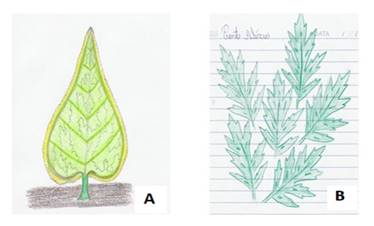
Fig. 2 Images representing drawings of students with some medicinal plants used by them and their families. A - Bilberry; B - Emergency Relief.
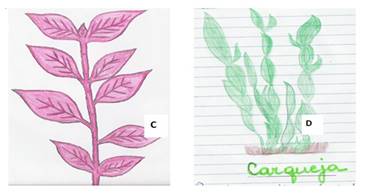
Fig. 3 Images representing drawings of students with some medicinal plants used by them and their families. C - Terramycin; D - gorse.
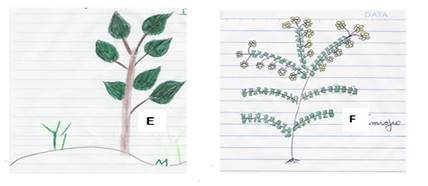
Fig. 4 Images representing drawings of students with some medicinal plants used by them and their families. E - Bilberry; D - Artemigio.
The research objectives joined those of the school, with teachers, staff and students being responsible for the construction of the bed with medicinal and aromatic plants within the school space, called “Viveiro Educador”, as well as the development of Environmental Education activities with school students. The construction of this nursery sought to stimulate, guide and support the implementation of a medical bed as a learning space, in order to make students realize, value and incorporate the educational dimension in their activities. It is intended, therefore, to take another step to achieve the reach of Environmental Education, meeting the growing demand that guide, technically and pedagogically, the production of seedlings as a continuous learning process (Fig. 5).
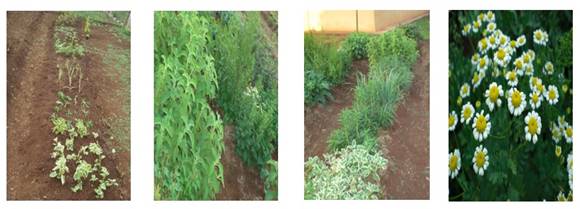
Fig. 5 Images that made up the evolution of the quantity of plants in the educator nursery, built for the research.
It was a very significant activity, where a very favorable and interesting pedagogical atmosphere was created for the practice of botanical activities, cultural knowledge, traditional knowledge and, subsequently, wide scientific dissemination. The students' families appropriated and took part in the project with great dedication, being highly productive for research as well as for their learning.
It is important to point out here that the knowledge dialogue is intrinsic to the environmental issue, but it is not perceived by most people as part of an Environmental Education process.
This work contributes to Environmental Education, also being presented as an important approach perspective for the enrichment of the understanding of the man-nature dynamics, assuming the dialogue between knowledge. Environmental Education poses the need to expand the dialogue between man and nature and between men, and, in addition, a practice of science knowledge and the integration of a set of non-academic knowledge. For Leff (2001), a new dialogue is needed that encompasses tradition and modernity, implying a process of cultural hybridization, where popular knowledge produced by different cultures is valued.
For Vinholi Junior & Vargas (2014), the linking of students' local knowledge with the content worked in high school in the classroom is seen, in this work, as a factor capable of collaborating with Meaningful Learning, as it allows articulations between theory and practice , being able to build learning through the observations and analyzes observed and experienced by the students.
The science teaching that we are used to experiencing in most schools is something disconnected from the student's reality; it is a fragmented knowledge that does not arouse students' interest. This teaching has reinforced the view of science as something static, as a set of immutable truths, of conceptual structures frozen in time. The blame for this situation is due to the lack of dialogue between scientific language and everyday language, between the reality created by science, and the reality of everyday life, between scientific theory and the practice of phenomena, between scientific principles and the social and technological contexts in which they materialize.
One possibility of minimizing or overcoming this distance between school and culture, school and daily life, would be the insertion of knowledge arising from the historical and cultural context of each group where the school is inserted, that is, in the classroom. The curriculum is understood as the entire collection of knowledge worked at school, including the ways of transmitting this knowledge and the human relationships built in daily life. Traditional knowledge, in this sense, could contribute effectively to bridge the distance between school and community, becoming an important element to make science teaching something stimulating, challenging and inserted in the interests of the student (Souza & Santos, 2018).
The local knowledge of the community, specifically regarding medicinal plants, should be sought, in order to have mechanisms that encourage the practice of Environmental Education in a region that may gradually lose it cultural identity, with the implementation of activities that little by little fragment and even hide these traditional knowledge, important and full of symbolism, magic and a reality that was built based on popular knowledge and manifestations.
The moment of dialogues, homemade preparations, popular medical knowledge, the transfer of information to the new generations, among others, are rich actions in the transmission of knowledge, based on the strong orality that permeates these actions. The use of these elements in an educational proposal, using Environmental Education as an instrument, should provide for its gradual introduction within the formality of schooled knowledge (Guarim-Neto, 2006).
Enumerating the already known totality of plants for medicinal use in the community is not the objective of this work, but rather, in a snippet, to provide data on some plants, to offer a basic reference to reflect on the Environmental Education practices with medicinal plants as a pedagogical tool, emanating in the context of the relationships that are established between the residents and students of the community and the plants that are valuable to them.
Environmental Education through the environment takes the physical medium as a double didactic resource: as a means to investigate and discover the world through observation and direct contact, and also as a starting point for developing integrated learning projects.
In order to transform desires and feelings into active proposals, possibilities for transforming reality and Meaningful Learning, Environmental Education activities were developed during the work. Field classes were held from the school surroundings to the high points of a hill located close to the school, where the dimension of the community space can be shown. This activity sought to carry out a reading of the different environmental perceptions expressed by the students and their previous knowledge about contents of Botany, in order, even, to form an initial reference for the work.
Taking advantage of the opportunity to count on the presence of teachers from other disciplines, issues related to ecological awareness were also addressed, exposing our concerns regarding the preservation of the local environment. Conceptual problems regarding the definition of living and non-living beings, differentiations between organisms and compression about biological organization were also very evident. These questions started to guide the planning of the contents of Biology and Geography to be worked with the students, in addition to the knowledge coming from the social field in which they are inserted.
Brazilian law No. 9795/99 in its Article 1 understands Environmental Education as the process by which the individual and the community build social values, skills, attitudes and competences aimed at the conservation of the environment, essential to the quality of life and sustainability. According to the basic principles of Environmental Education, indicated by this Law, the themes Environmental Education and the formation of environmental awareness must be worked as content in formal education, as it is understood that in order to form environmental awareness, that is, a change in values and conduct on the part of the students, it is necessary that the pedagogical practice be carried out in an articulated way between the different disciplines in an interdisciplinary way.
To promote an environmental educational process for research with medicinal plants, it is possible to initially achieve greater integration with the environment, where medicinal plants were treated as a “generating theme” of discussions for the production of knowledge, achieved through dialogues and in search of the relationship between theory and practice, thinking and doing. Throughout the process of research and educational action, autonomy, participation and collaboration, the exploration of different points of view, were sought for critical reflective action, linked to ethics, aesthetics, education, work and social practices.
The local knowledge about the treatment of different ailments that disturb / affect the human being is generally evidenced in conversations with the older people (inserting the healers, the housewives, etc.) that, for a reason or another, they carry with them precious information received from their ancestors. The recovery of this information is important, given that it serves as a subsidy for the knowledge of the medicinal potential of the national flora, in addition to helping substantially in the discussion of the issue of the use and maintenance of biodiversity. In this work, this knowledge can also provide fertile paths for the praxis of Environmental Education, having these plants as efficient pedagogical instruments, as elements that can subsidize the educational-environmental relationship, offering opportunities for insertion of different aspects (Freire, 1985).
Throughout the work, we tried to instigate students to research and share the knowledge built in their social field and in the family, and in some classes it was requested to perform tasks at home, with the family. The purpose of these tasks was to establish a relationship between the knowledge built in the students' social circle and those of the scientific culture worked in class.
In the face of knowledge, the knowledge of the community about medicinal plants, exposed here partially, a space is also opened to discuss the perpetuation of this knowledge and its practices among the generations of their descendants, knowledge that is entrusted to us as researchers in the field of ethno-knowledge, plant resources and human populations.
Conclusions
In the present study, the insertion of popular knowledge about medicinal plants in the classrooms opened up possibilities for a dialogue between knowledge, especially between the students' empirical knowledge and some contents worked on in the Teaching of Botany. The pedagogical interventions, in terms of raising awareness about the importance of this strategy for students, in the face of cultural diversity, were quite satisfactory, which allows us to affirm that the dialogue between knowledge in Science Education can help in the promotion of Meaningful Learning. However, it is necessary to be very careful with how to explore the local knowledge of students and the community, in order to contribute to the learning of scientific concepts.
The pleasure of studying through the appreciation of one's own culture motivates students towards more meaningful learning. In addition, promoting a cognitive and relaxed environment avoids complacency, disinterest and discouragement, and promotes pleasure in studying and learning.
A factor that favored this research was the fact that most students, since childhood, and lived in close contact with nature, since the flora of the community region is extremely privileged by the diversity and beauty of their landscapes. In the case of Teaching Botany, this becomes a very positive factor to understand, for example, the main aspects of plant morphology and classification, as the experience and contact with plants enabled good knowledge available in their cognitive structure, sufficient to be able to relate to the content presented.
The practical classes aroused, in general, a great interest of the students, building rich moments in the teaching-learning process, encouraging them to explain what they learned in their own words, in addition to providing a constructive knowledge dialogue between teacher and students.
The receptivity on the part of the students was evidenced, because in this form of work, the learning experience is active and articulated with its reality; and mainly directed to ideas, feelings and actions, in a space rich in culture that contributed to the success of the methodology suggested and put into practice.
The notions brought up in this work are challenges to education. They are intertwined notions and challenges, which concern the formation of subjects: the ecological subject that Environmental Education aims for; the political subject that Rural Education wants to strengthen; of the subjects of knowledge, autonomous in the production of knowledge, that the continuing education intends to forge.
Finally, the work provides some bases, albeit preliminary, to understand how local and traditional knowledge, combined with Environmental Education processes, can contribute to students perceiving themselves as agents of social transformation in the community. In this sense, medicinal plants can represent a theme that generates changes in social and environmental attitudes. However, the way in which the partnership between knowledge will be constituted, still demands new investigations, experiences and studies.














